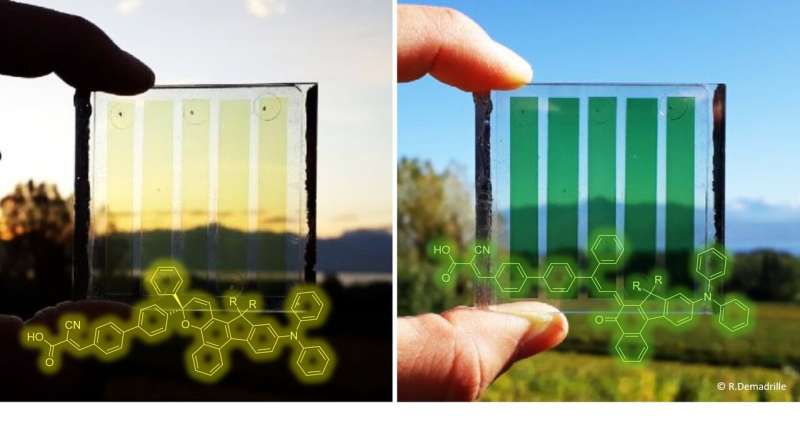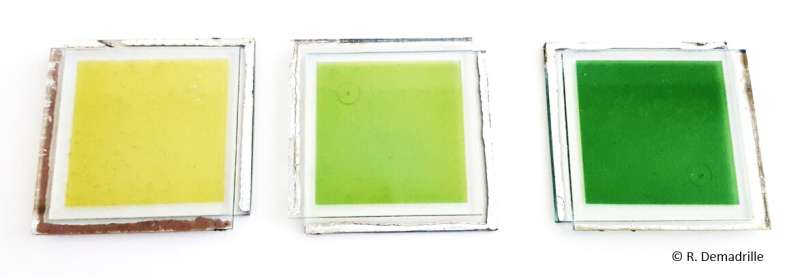The solar cells developed by the researchers in the evening (left) and during the day (right). Credit: Demadrille et al.
Solar cells made of semi-transparent photovoltaic (PV) materials typically have a fixed optical transmission, which results in either high transparency or high efficiency, but rarely both. In order to perform optimally when integrated on buildings, however, they should be able to generate electricity efficiently, while also changing how much they transmit light based on the intensity of natural light in their surroundings.
Researchers from CEA at Université Grenoble Alpes-CNRS, Solaronix and Universidad Pablo de Olavide proposed a strategy to fabricate solar cells that can adapt to changing light conditions, while also achieving high power conversion efficiencies. This strategy, outlined in a paper published in Nature Energy, entails sensitizing the cells using dyes that they developed that enable a change in color when exposed to light.
"In 2014, we were working on the development of organic dyes for use in semi-transparent, dye-sensitized solar cells (DSSCs) with Solaronix, for building integrated photovoltaics," Renaud Demadrille, one of the researchers who carried out the study, told TechXplore. "One of our dyes was selected for the fabrication of orange panels installed in the solar facade at the EPFL conference center."
After integrating solar cells they developed in real-world settings and evaluating their performance, the researchers realized that while they were aesthetically pleasing, their manufacture unavoidably resulted in a trade-off between transparency and power efficiency. This is far from ideal, especially if the cells are to be incorporated on windows or other surfaces that are typically transparent.
"We realized that, ideally, semi-transparent solar cells should generate electricity while offering the comfort for users to self-adjust their light transmission with the intensity of the daylight," Demadrille said. "This self-adjusting feature could help mitigate the amount of light (when the cells are exposed to full sun) and the temperature of buildings with large windows and/or glass facades. We thus decided to develop a new class of dyes that that can enable these properties."
The solar cells developed by the researchers in their different color conditions. Credit: Demadrille et al.
The solar cells presented by Demadrille and his colleagues were fabricated using photochromic dyes. When they are exposed to light, the absorption properties of these dyes are altered, which results in a change of color. When solar cells are sensitized using these dyes, they acquire the same color-changing properties.
The photochromic dyes used by the researchers enable the fabrication of solar cells that become darker when the amount of sunlight in their surrounding environment increases and more transparent when it decreases. When they are exposed to strong sunlight and thus gain a darker color, the cells also generate a larger amount of electrical power.
"This coloration/discoloration process can be repeated over several months without loss," Demadrille said. "In other semi-transparent solar cells technology, the light-transmission property is fixed during fabrication and cannot be changed."
The researchers evaluated their DSSCs in a series of experiments and found that their transparency ranged between 60% and 27%, depending on the intensity of sunlight in their surroundings, yet they also achieved a power conversion efficiency of 4.17%. Remarkably, theirs are the first solar cells ever developed capable of adapting to changing light conditions. This characteristic allows them to capture solar energy during the day and to filter less light that passes through them as it gets darker, for instance, in the evening or early morning.
In the future, the solar cells introduced by Demadrille and his colleagues could be integrated on building windows or on other surfaces that may benefit from being transparent during the darkest hours of the day. In addition, the photochromic dyes used on the cells could be applied to other photovoltaic materials in order to provide them with similar color-changing properties.
"We believe that with further improvements on their performance and stability, our cells will have the potential to be embedded in facades of buildings or even vehicles, serving as solar windows," Demadrille said. "In our next studies, we thus plan to explore ways of improving their electrical performance and stability. Meanwhile, we are also working on a second generation of dyes with a faster self-adaptive response to light conditions."
More information: Quentin Huaulmé et al. Photochromic dye-sensitized solar cells with light-driven adjustable optical transmission and power conversion efficiency, Nature Energy (2020). DOI: 10.1038/s41560-020-0624-7
SwissTech: www.solaronix.com/news/inaugur … h-convention-center/
Journal information: Nature Energy
© 2020 Science X Network

























